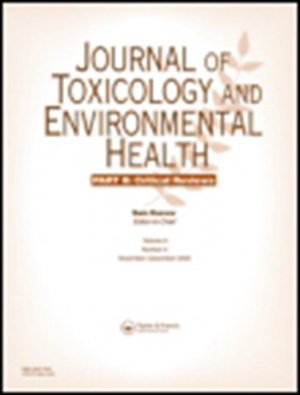Critical assessment of pendimethalin in terms of persistence, bioaccumulation, toxicity, and potential for long-range transport
IF 6.4
2区 医学
Q1 ENVIRONMENTAL SCIENCES
Journal of Toxicology and Environmental Health-Part B-Critical Reviews
Pub Date : 2017-01-02
DOI:10.1080/10937404.2016.1222320
引用次数: 47
Abstract
ABSTRACT Pendimethalin (PND, CAS registry number 40487-42-1) is a dinitroaniline herbicide that selectively controls broad-leaf and grassy weeds in a variety of crops and in noncrop areas. It has been on the market for about 30 yr and is currently under review for properties related to persistence (P), bioaccumulation (B), and toxicity (T) in the European Union (EU). A critical review of these properties as well as potential for long-range transport (LRT) was conducted. Pendimethalin has a geometric mean (GM) half-life of 76–98 d in agriculturally relevant soils under aerobic conditions in the lab. The anaerobic half-life was 12 d. The GM for field half-lives was 72 d. The GM half-life for sediment-water tests in the lab was 20 d and that in field aquatic cosms ranged from 45 to 90 d. From these data PND is not persistent as defined in the Annex II of EC regulation 1107/2009. The GM bioconcentration factor for PND was 1878, less than the criterion value. This was consistent with lack of biomagnification or accumulation in aquatic and terrestrial food chains. The GM no-observed-effect concentration (NOEC) value for fish was 43 µg/L, and 11 µg/L for algae. These do not trigger the criterion value for toxicity. In air, the DT50 of PND was estimated to be 0.35 d, which is well below the criterion of 2 d for LRT under the United Nations Economic Commission for Europe (UNECE) Aarhus protocol. Modeling confirmed lack of LRT. Because of its volatility, PND may be transported over short distances in air and was found in samples in local and semiremote regions; however, these concentrations are not of toxicological concern. Unlike other current-use pesticides, PND has not been found in samples from remote regions since 2000 and there is no apparent evidence that this herbicide accumulates in food chains in the Arctic.从持久性、生物蓄积性、毒性和远距离运输潜力方面对二甲甲烷进行关键评估
戊二甲基灵(PND, CAS注册号40487-42-1)是一种二硝基苯胺类除草剂,可选择性防治多种作物和非作物地区的阔叶杂草和草类杂草。它已上市约30年,目前正在欧盟(EU)审查与持久性(P),生物蓄积性(B)和毒性(T)有关的特性。对这些特性以及远程传输(LRT)的潜力进行了评述。在实验室有氧条件下,戊二甲基灵在农业相关土壤中的几何平均半衰期为76-98 d。厌氧半衰期为12天。野外转基因半衰期为72天。实验室沉积物-水试验的转基因半衰期为20天,野外水生生物的半衰期为45至90天。从这些数据来看,PND不符合欧盟法规1107/2009附件II所定义的持久性。PND的转基因生物富集因子为1878,小于标准值。这与水生和陆生食物链中缺乏生物放大或积累是一致的。转基因无效应浓度(NOEC)对鱼类为43µg/L,对藻类为11µg/L。这些不会触发毒性的标准值。在空气中,PND的DT50估计为0.35 d,远低于联合国欧洲经济委员会(欧洲经委会)奥尔胡斯议定书中轻轨2 d的标准。模型证实缺乏LRT。由于其挥发性,PND可以在空气中短距离传播,并在当地和半偏远地区的样品中发现;然而,这些浓度没有毒理学问题。与其他目前使用的农药不同,自2000年以来,在偏远地区的样本中没有发现PND,也没有明显的证据表明这种除草剂在北极的食物链中积累。
本文章由计算机程序翻译,如有差异,请以英文原文为准。
求助全文
约1分钟内获得全文
求助全文
来源期刊
CiteScore
13.80
自引率
6.90%
发文量
13
审稿时长
>24 weeks
期刊介绍:
"Journal of Toxicology and Environmental Health: Part B - Critical Reviews" is an academic journal published by Taylor & Francis, focusing on the critical examination of research in the areas of environmental exposure and population health. With an ISSN identifier of 1093-7404, this journal has established itself as a significant source of scholarly content in the field of toxicology and environmental health.
Since its inception, the journal has published over 424 articles that have garnered 35,097 citations, reflecting its impact and relevance in the scientific community. Known for its comprehensive reviews, the journal also goes by the names "Critical Reviews" and "Journal of Toxicology & Environmental Health, Part B, Critical Reviews."
The journal's mission is to provide a platform for in-depth analysis and critical discussion of the latest findings in toxicology, environmental health, and related disciplines. By doing so, it contributes to the advancement of knowledge and understanding of the complex interactions between environmental factors and human health, aiding in the development of strategies to protect and improve public health.

 求助内容:
求助内容: 应助结果提醒方式:
应助结果提醒方式:


